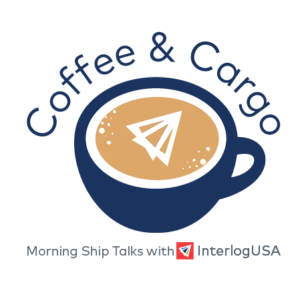Competitive Edge
December 8th, 2021
Stay Current with Interlog’s Weekly Newsletter:
Sign up for our next Coffee & Cargo webinar –> CLICK HERE
Ocean Freight Market Update
IMPORT: Europe to North America
Notable Ports with Congestion: 77 Backlogged Vessels (LA/LB); 25 Backlogged Vessels (Savannah)
Rates: December rates remain high for both USEC and USWC. Peak season surcharges (PSS) increases for USWC ports have been activated by a few lines.
Space: Critical for both USEC and USWC. Especially, USWC.
Capacity: Capacity remains tight for both North Europe and Mediterranean services. Shortages at inland depots. However, better equipment availability at ports.
TIPS: Book 5 or more weeks prior to CRD. Request premium service for higher reliability and no-roll guarantees.
IMPORT: Asia to North America
Recent Developments
- Demand will remain strong as capacity tightens on TPEB lanes.
- Around 15% of capacity in December may be unavailable due to congestion-related delays and vessel recovery measures.
- Less space and higher demand remain to keep pressure on the market and bolster higher rates.
Port Congestion: Remains severe at Los Angeles/Long Beach and Savannah ports. Vancouver port also faces challenges amid recent weather.
Rates: A few carriers have implemented GRIs for December. Rate levels stay elevated with raising demand.
Capacity: Remains critical and severely undercapacity.
TIPS: Book 5 or more weeks prior to CRD. Request premium service for higher reliability and no-roll guarantees.
EXPORT: North America to Asia
Recent Developments
- Vessel arrivals and available capacity remain fluid for USWC POLs.
- Delays and diminishing schedule integrityare presenting challenges with posted return days and vessel cut-offs at ports.
Rates: Multiple GRIs are likely to be implemented for Indian destinations that require transshipment and Australian destinations.
Equipment: IPI origins are adversely impacted with shortages in containers and chassis.
TIPS: Place bookings 4 to 6 weeks in advance to secure your equipment and vessel space.
Did You Know?
A large cargo ship uses 150-250 tons of fuel per day!
Freight News
COVID Outbreak on Hapag-Lloyd Vessel, diverting to Mexico
A Hapag-Lloyd vessel diverts to Mexico after a COVID outbreak hospitalizes three crew members and quarantines two. According to Freightwaves a container ship, the MV Rome Express, which has the capacity to carry 12,552 twenty-foot equivalent units, made an unexpected port call in Ensenada after five crew members contracted the virus.
Hapag-Lloyd said there is the potential for cargo to be delayed, as the vessel would stay at the port until different crew were tested and cleared to board. However, according to Marine Traffic and reported by Freightwaves the MV Rome is now underway again in the Pacific Ocean.
24… 56…96! Container ships are still waiting to dock in Southern California ports
As of Friday, 40 container ships were waiting for berths within 40 miles of the ports in Los Angeles and Long Beach, however an additional 56 container ships have also been waiting for berth, just a little farther out at sea, according to the Marine Exchange of Southern California and reported by Freightwaves. Along with the 96 container ships waiting to dock, there were 31 container ships at terminal berths, bringing the overall total to 127, at or near an all-time high.
It shouldn’t come to a shock for anyone but the total number of container ships either at berths or waiting offshore continues to rise, as it is up 25% from the beginning of November, 41% from the beginning of October and 79% from the beginning of September reported by Freightwaves.
Since mid-November, the Marine Exchange unveiled a new queuing system to encourage container ships to wait outside of a specially designed Safety and Air Quality Area (SAQA) that extends 150 miles to the west of the ports and 50 miles to the north and south reported by Freightwaves. This system allows a ship to reserve a spot in line based on it’s calculated time of arrival (CTA), instead of a first-come, first-served system that entered a ship in the queueing list when it came within 20 miles of the ports, which was in place before.
Sign up for our
industry answers
Our team works to provide valuable, unique, and relevant content to assist you in finding solutions. Sign up now.

